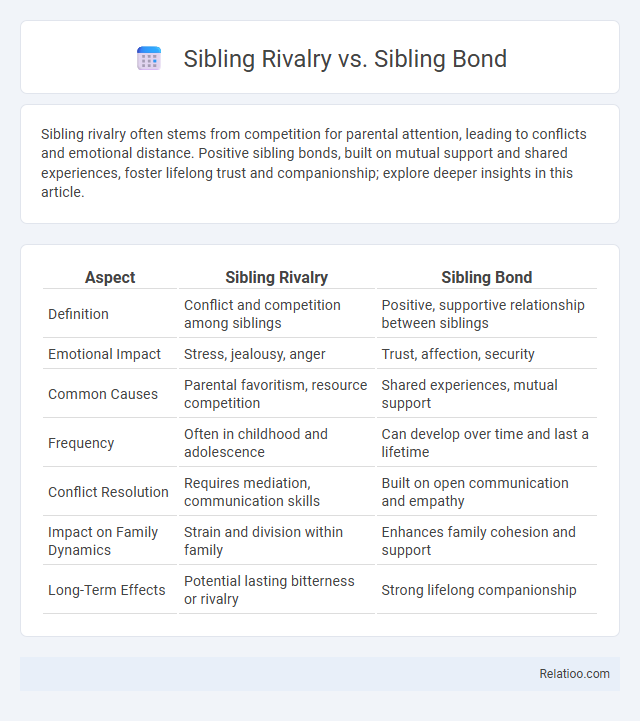Sibling rivalry often stems from competition for parental attention, leading to conflicts and emotional distance. Positive sibling bonds, built on mutual support and shared experiences, foster lifelong trust and companionship; explore deeper insights in this article.
Table of Comparison
| Aspect | Sibling Rivalry | Sibling Bond |
|---|---|---|
| Definition | Conflict and competition among siblings | Positive, supportive relationship between siblings |
| Emotional Impact | Stress, jealousy, anger | Trust, affection, security |
| Common Causes | Parental favoritism, resource competition | Shared experiences, mutual support |
| Frequency | Often in childhood and adolescence | Can develop over time and last a lifetime |
| Conflict Resolution | Requires mediation, communication skills | Built on open communication and empathy |
| Impact on Family Dynamics | Strain and division within family | Enhances family cohesion and support |
| Long-Term Effects | Potential lasting bitterness or rivalry | Strong lifelong companionship |
Understanding Sibling Dynamics: Rivalry vs Bond
Understanding sibling dynamics involves recognizing the balance between sibling rivalry and sibling bonds, which shape your family's emotional environment. Sibling rivalry often emerges from competition for parental attention and resources, while sibling bonds develop through shared experiences and mutual support, fostering closeness and resilience. By identifying these patterns, you can promote healthier interactions and strengthen positive relationships among siblings.
Causes of Sibling Rivalry
Sibling rivalry often stems from competition for parental attention, limited resources, and differences in personality or age, which can create tension and conflict between siblings. Understanding the root causes of sibling rivalry helps you foster a stronger sibling bond by addressing jealousy, favoritism, and unmet emotional needs through effective communication and empathy. Encouraging shared experiences and mutual respect can transform sibling rivalry into a healthy, supportive relationship.
Factors That Strengthen Sibling Bonds
Shared experiences, effective communication, and mutual respect are key factors that strengthen sibling bonds despite the presence of sibling rivalry. You can foster a supportive relationship by encouraging empathy, cooperation, and celebrating each sibling's unique strengths. Building trust through consistent positive interactions helps transform rivalry into a foundation for lifelong connection.
The Psychological Impact of Sibling Relationships
Sibling relationships significantly influence individual psychological development, with sibling rivalry often linked to increased stress, anxiety, and lowered self-esteem due to constant competition and comparison. In contrast, a strong sibling bond fosters emotional support, social skills, and resilience, contributing positively to mental health and well-being. Understanding the dynamics of sibling rivalry and bonding is crucial for addressing childhood behavioral issues and promoting healthy interpersonal relationships in adulthood.
Parental Influence on Sibling Interactions
Parental influence significantly shapes sibling interactions, often dictating whether rivalry or bonding dominates. Authoritative parenting that fosters open communication and fairness tends to promote strong sibling bonds, reducing conflict and competition. In contrast, inconsistent discipline or favoritism can exacerbate sibling rivalry, intensifying jealousy and hostility between siblings.
Common Signs of Sibling Rivalry
Common signs of sibling rivalry include frequent arguments, jealousy, and competition for parental attention. These behaviors often manifest through teasing, physical fights, and negative comparisons between siblings. Recognizing these signs early can help parents foster a stronger sibling bond and reduce ongoing conflicts.
Benefits of a Strong Sibling Bond
A strong sibling bond fosters emotional support, resilience, and social skills that benefit Your lifelong relationships and mental well-being. Unlike sibling rivalry, which can cause stress and conflict, a positive connection encourages cooperation, empathy, and shared experiences that promote personal growth. Developing a close sibling relationship enhances communication and trust, laying a foundation for a stable support system throughout life.
Strategies for Reducing Sibling Rivalry
Strategies for reducing sibling rivalry include establishing clear family rules, encouraging positive communication, and promoting individual recognition to address each child's unique needs. Consistent discipline and fair treatment by parents help prevent feelings of favoritism, while scheduling regular family activities fosters bonding and shared experiences. Teaching conflict resolution skills enables siblings to manage disagreements constructively, strengthening the sibling bond and minimizing rivalry.
Nurturing Lasting Sibling Connections
Sibling rivalry often stems from competition and jealousy, creating tension that can challenge family harmony. In contrast, nurturing a sibling bond involves fostering empathy, communication, and shared experiences to strengthen lifelong connections. Focusing on positive reinforcement and conflict resolution skills helps transform rivalry into supportive relationships, ensuring enduring sibling connections.
Sibling Rivalry vs Bond: Long-Term Effects
Sibling rivalry often leads to increased stress and lower self-esteem over time, potentially causing lasting emotional distance between siblings. In contrast, a strong sibling bond promotes social development, resilience, and emotional support throughout adulthood. Understanding the long-term effects of rivalry versus bonding helps in fostering healthier family relationships and improving psychological well-being.

Infographic: Sibling Rivalry vs Sibling Bond
 relatioo.com
relatioo.com